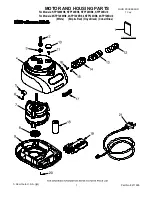
UG-707
ADV8005 Hardware Reference Manual
dac1to3_tuning[7:0]
, Encoder Map,
Address 0xE40B[7:0]
This register is used to set the gain for DACs 1-3 output voltage.
Function
dac1to3_tuning[7:0]
Description
11000000
-7.5%
11000001
-7.382%
11000010
-7.364%
...
11111111
-0.018%
00000000 (default)
0%
00000001
0.018%
00000010
0.036%
...
00111111
+7.382%
01000000
+7.5%
The reset value of the control registers is 0x00; that is, nominal DAC current is output.
shows how the output current of the DACs varies
for a nominal 4.33 mA output current.
Table 77: DAC Gain Control
DAC Gain Register Value
DAC Current (mA)
% Gain
Note
0100 0000 (0x40)
4.658
7.5000%
0011 1111 (0x3F)
4.653
7.3820%
0011 1110 (0x3E)
4.648
7.3640%
…
…
…
…
…
…
0000 0010 (0x02)
4.43
0.0360%
0000 0001 (0x01)
4.38
0.0180%
0000 0000 (0x00)
4.33
0.0000%
Reset value, nominal
1111 1111 (0xFF)
4.25
−0.0180%
1111 1110 (0xFE)
4.23
−0.0360%
…
…
…
…
…
…
1100 0010 (0xC2)
4.018
−7.3640%
1100 0001 (0xC1)
4.013
−7.3820%
1100 0000 (0xC0)
4.008
−7.5000%
7.4.17.
Gamma Correction
Generally, gamma correction is applied to compensate for the nonlinear relationship between the signal input and the output brightness level (as
perceived on a CRT). It can also be applied wherever nonlinear processing is used.
Gamma correction uses the function:
Signal
OUT
= (
Signal
IN
)
γ
where γ is the gamma correction factor.
Gamma correction is available for SD and ED/HD video. For both variations, there are twenty 8-bit registers, used to program the Gamma
Correction Curve A and Gamma Correction Curve B.
Gamma correction is performed on the luma data only. The user can choose one of two correction curves, Curve A or Curve B. Only one of
these curves can be used at a time.
The shape of the gamma correction curve is controlled by defining the curve response at 10 different locations along the curve. By altering the
response at these locations, the shape of the gamma correction curve can be modified. Between these points, linear interpolation is used to
Rev. A | Page 262 of 317
















































